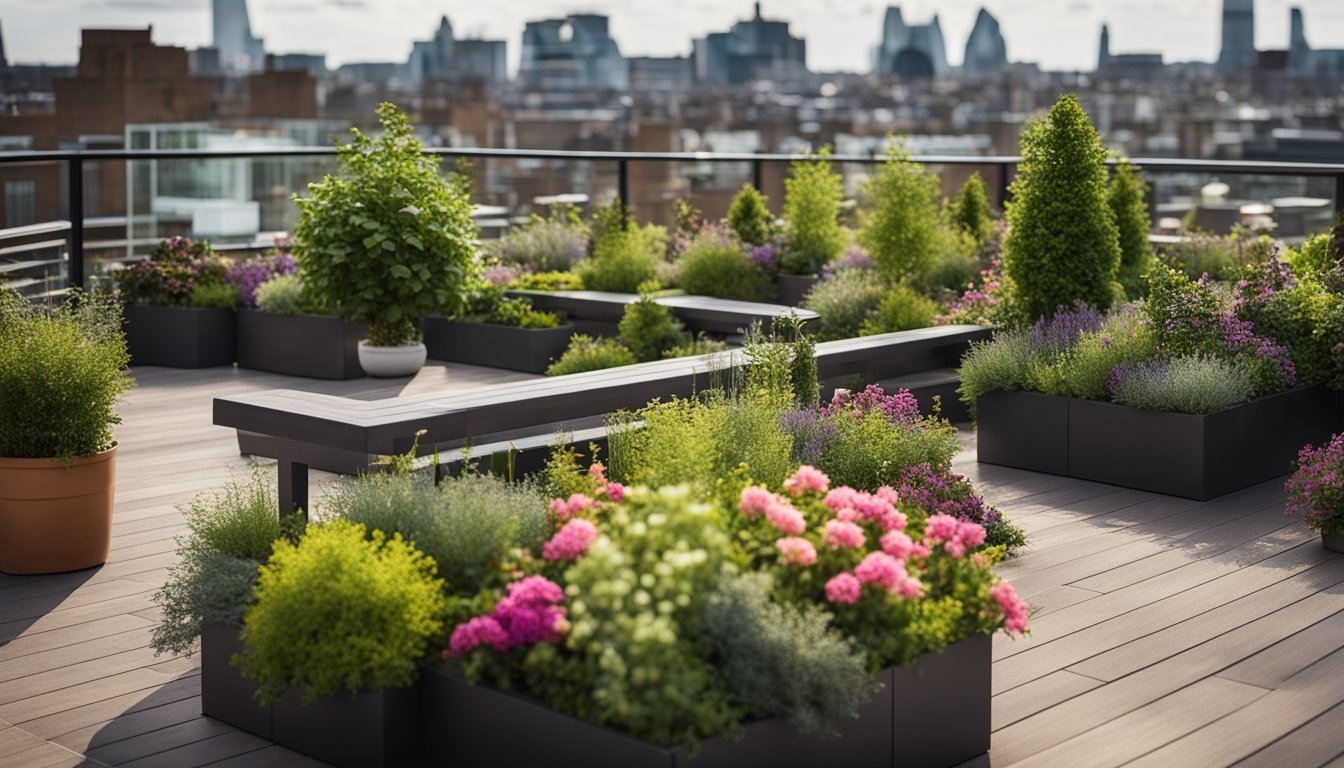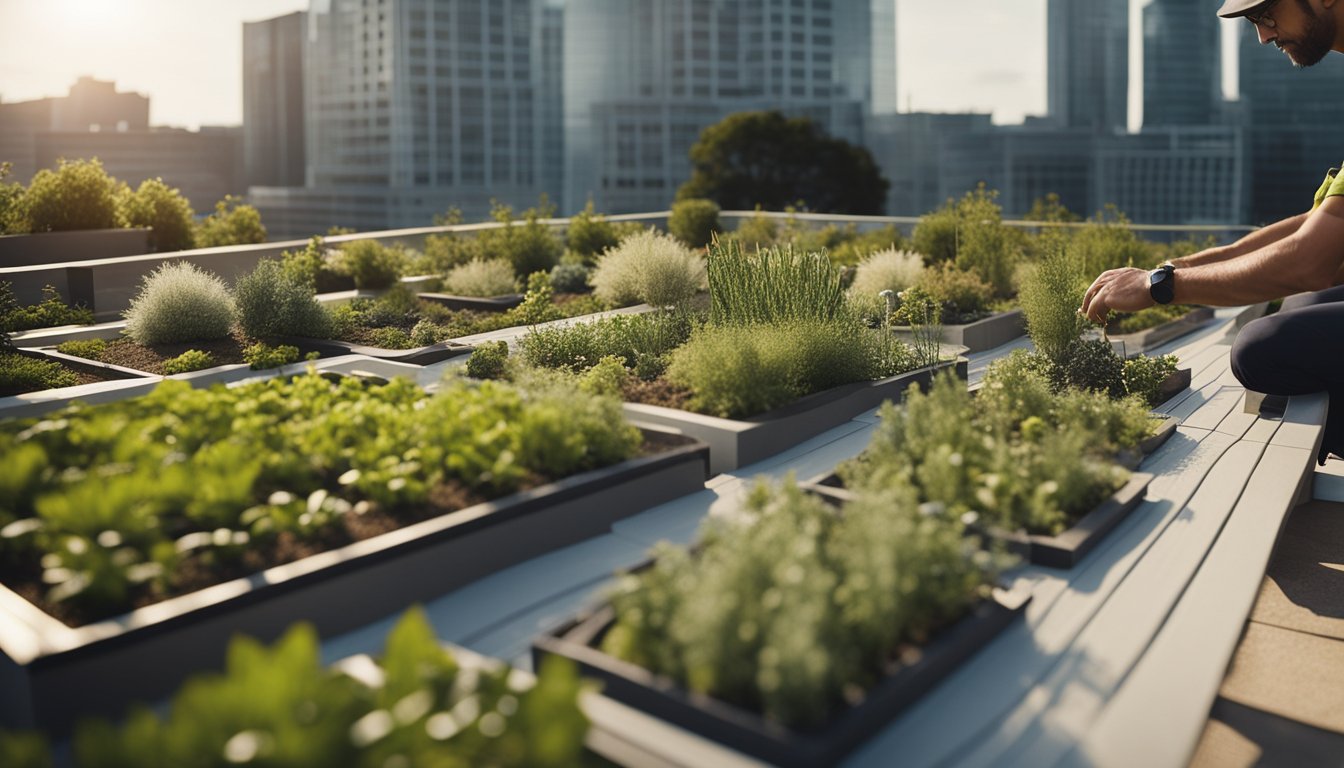Late updated: 19 Aug 2024 11:08
Written by: Oliver Bennett
Planning A Roof Garden For Your UK Home: Essential Tips and Ideas
Planning a roof garden for your UK home brings both beauty and a touch of nature to urban living spaces. It's an exciting venture that allows us to make the most out of limited space while adding value and an aesthetic appeal to our home. Understanding the key aspects of garden design, such as weight considerations and suitable plants, ensures a successful and sustainable rooftop oasis.

We need to start by assessing how much weight our roof can support, as adding planters and soil can become quite heavy. Once we have a clear understanding of this, selecting the right materials and plants becomes crucial. Choosing lightweight containers and drought-resistant plants can help in maintaining our garden with minimal effort.
Creating a roof garden isn't just about the practicalities; it also opens up endless design possibilities. From sleek, modern layouts to more rustic touches, there's a style to suit every taste. Key materials like polished stone or clay pavers can enhance the garden’s appeal, making our rooftop not just a functional space but a personal sanctuary.
Key Takeaways
- Assess roof weight capacity before starting your project.
- Use lightweight containers and drought-resistant plants for ease of maintenance.
- Choose design elements that align with your personal style and enhance the overall aesthetic.
Planning and Design Considerations

When planning a roof garden, it's essential to focus on structural capacity, comply with building regulations, create a functional layout, and carefully choose materials and plants.
Assessing Structural Capacity
We must first evaluate the structural capacity of our roof. A structural engineer can determine whether the roof can withstand the additional weight of a garden. It's important to consider the cumulative weight of soil, planters, furniture, and plants.
Engaging a professional ensures our terrace remains safe. The structural assessment may involve drilling small holes to inspect the underlying framework. Depending on the results, we might need to reinforce certain areas. Always prioritise safety to prevent structural damage.
Navigating Building Regulations
Understanding and navigating building regulations is crucial. In the UK, certain roof gardens may fall under permitted development rights, but specific conditions and limitations apply. Consulting an architect or a surveyor can clarify these requirements.
We need to ensure our garden design aligns with local building codes. This includes adhering to height restrictions and ensuring no negative impact on neighbours. Obtaining necessary permissions before starting any construction work is essential to avoid future legal hassles.
Creating a Functional Layout
Designing a functional layout involves practical placements and efficient use of space. Planters should be set in from the roof's perimeter to prevent individuals from standing too close to the edge. This design choice also maximises safety.
We should consider accessibility and movement, ensuring pathways are clear. Dividing the space based on functionality – such as seating, planting, and storage areas – creates an organised look. A well-thought-out layout enhances the overall usability and aesthetic appeal of our roof garden.
Choosing Materials and Plants Wisely
Selecting appropriate materials and plants is key to a successful roof garden. Materials such as polished stone, concrete, and Cor-Ten steel are durable and visually appealing. We should choose materials that are permeable to water and UV-resistant to withstand outdoor conditions.
As for plants, it's important to assess their weight and maintenance requirements. Opt for lightweight planters and consider the garden's exposure to wind and sunlight. Using native and drought-resistant plants can reduce maintenance efforts and enhance sustainability. Proper plant selection ensures a vibrant and thriving roof garden year-round.
Installation and Maintenance

When setting up a roof garden, proper installation and regular maintenance are crucial for its success. It's essential to carefully consider the systems, plants, and care routines to ensure the garden thrives year-round.
Installing Essential Systems
Installing essential systems starts with selecting appropriate waterproofing materials. EPDM or PVC membranes are ideal choices as they are durable and resistant to water infiltration. Ensuring a robust drainage system is critical to prevent water accumulation, which can damage the structure and plants.
We should also consider lightweight, sturdy flooring material that can withstand varying weather conditions. Using modular flooring systems allows for easy installation and adjustments. Ensuring these systems are in place creates a stable foundation for the roof garden.
Selecting and Planting Cultivation
Choosing the right plants is pivotal. Evergreen varieties such as lavender and rosemary provide year-long greenery and require low maintenance. Perennials are also excellent as they return each year without requiring replanting. Sourcing good-quality soil and suitable planters ensures healthy plant growth.
When planting, consider using raised beds and pots. They help manage soil quality and make it easier to implement irrigation systems. Grouping plants with similar water needs simplifies maintenance and ensures each plant thrives in its allocated space.
Caring for Your Roof Garden
Maintaining a roof garden involves regular watering, especially during dry spells. Drip irrigation systems can be installed to automate watering and ensure consistent moisture levels. We should inspect the garden regularly to check for pests and diseases, promptly addressing any issues.
Seasonal pruning and fertilising keep plants healthy and encourage growth. Mulching helps retain soil moisture and reduces weeds. Monitoring the drainage system ensures it remains effective, preventing waterlogging or structural damage. Routine care allows our roof garden to flourish and remain a beautiful retreat.
Frequently Asked Questions
In this section, we address common questions related to planning and maintaining a rooftop garden in the UK. We cover everything from essential steps to plant selection, soil depth, and maintenance considerations for a successful rooftop garden.
What are the essential steps in creating a rooftop garden in the UK?
First, check if your roof can support the additional weight of a garden. This includes people, soil, and plants. Consult a structural engineer if necessary.
Next, confirm if you need planning permission, which may depend on your local council's regulations. Afterward, you can design the layout, choose suitable plants, and set up proper drainage.
Can you provide design ideas for a small rooftop garden?
Small rooftop gardens can benefit from vertical planting to save space. Use wall-mounted planters or shelves for herbs and flowers.
Incorporate multi-functional furniture like benches with storage underneath. Opt for lightweight pots and containers to keep the load manageable. Also, consider adding elements like fairy lights or compact water features to enhance ambience.
What are the latest trends in contemporary rooftop garden designs?
Eco-friendly designs are gaining popularity. This includes using recycled materials and sustainable practices.
Green roofs with low-maintenance plants, such as sedums and grasses, are also trending. Integrated technology, like automated irrigation systems and smart lighting, is becoming more common.
Modern designs often feature minimalistic furniture and clean lines, giving the space a sleek appearance.
What should be considered when planning plant selection for a roof terrace?
Choose plants that can withstand wind and sun exposure. Hardy perennials, shrubs, and grasses are often ideal.
Opt for drought-resistant plants to minimise watering needs. Native plants that are well-suited to the UK climate can help ensure long-term success.
Consider how the plants' root systems will interact with your containers to avoid structural damage.
What is the recommended soil depth for a rooftop garden?
Soil depth varies depending on the plants you choose. For shallow-rooted plants like herbs and succulents, 10-20 cm is sufficient.
Vegetables and flowers may require 20-30 cm. Trees and large shrubs need at least 45-60 cm of soil. Ensure the soil is lightweight yet rich in nutrients to support healthy plant growth.
Are there any special considerations for maintaining a rooftop garden in the UK climate?
Regularly check for signs of wind or weather damage, as rooftops are more exposed to the elements.
Use mulch to retain moisture and protect plant roots from temperature fluctuations. Incorporate drought-tolerant plants to deal with dry spells. Ensure proper drainage to avoid waterlogging during heavy rains.
By following these steps, we can create and maintain a thriving rooftop garden tailored to the UK's unique climate.
